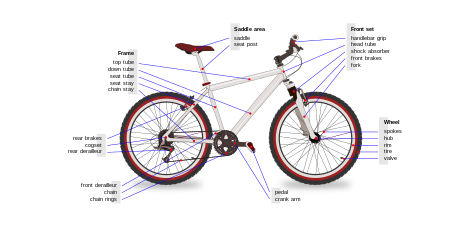
A valve is a device or natural object that regulates, directs or controls the flow of a fluid by opening, closing, or partially obstructing various passageways. Valves are technically fittings, but are usually discussed as a separate category. In an open valve, fluid flows in a direction from higher pressure to lower pressure. The word is derived from the Latin valva, the moving part of a door, in turn from volvere, to turn, roll.
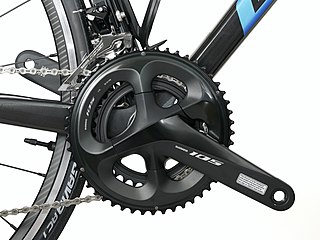
The crankset or chainset is the component of a bicycle drivetrain that converts the reciprocating motion of the rider's legs into rotational motion used to drive the chain or belt, which in turn drives the rear wheel. It consists of one or more sprockets, also called chainrings or chainwheels attached to the cranks, arms, or crankarms to which the pedals attach. It is connected to the rider by the pedals, to the bicycle frame by the bottom bracket, and to the rear sprocket, cassette or freewheel via the chain.

Taps and dies are tools used to create screw threads, which is called threading. Many are cutting tools; others are forming tools. A tap is used to cut or form the female portion of the mating pair. A die is used to cut or form the male portion of the mating pair. The process of cutting or forming threads using a tap is called tapping, whereas the process using a die is called threading.
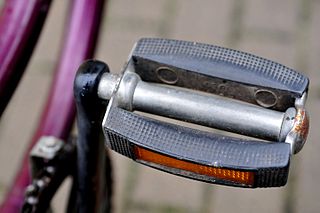
The pedal is the part of a bicycle that the rider pushes with their foot to propel the vehicle. It provides the connection between the cyclist's foot or shoe and the crank allowing the leg to turn the bottom bracket spindle and propel the bicycle's wheels. A pedal usually consists of a spindle that threads into the end of the crank, and a body on which the foot rest is attached, that is free to rotate on bearings with respect to the spindle.

A hubcap or hub cap is a decorative disk on an automobile wheel that covers at minimum the central portion of the wheel, called the hub. An automobile hubcap is used to cover the wheel hub and the wheel fasteners to reduce the accumulation of dirt and moisture. It also has the function of decorating the car.

The bottom bracket on a bicycle connects the crankset (chainset) to the bicycle and allows the crankset to rotate freely. It contains a spindle to which the crankset attaches, and the bearings that allow the spindle and crankset to rotate. The chainrings and pedals attach to the cranks. Bottom bracket bearings fit inside the bottom bracket shell, which connects the seat tube, down tube and chain stays as part of the bicycle frame.
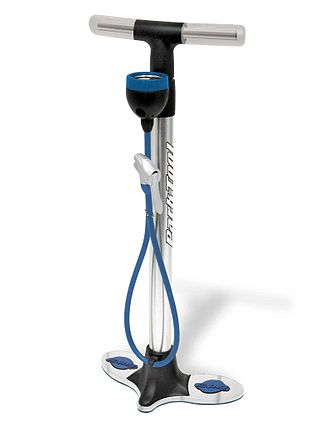
A bicycle pump is a type of positive-displacement air pump specifically designed for inflating bicycle tires. It has a connection or adapter for use with one or both of the two most common types of valves used on bicycles, Schrader or Presta. A third type of valve called the Dunlop valve exists, but tubes with these valves can be filled using a Presta pump.

The headset is the set of components on a bicycle that provides a rotatable interface between the bicycle fork and the head tube of a bicycle frame. The tube through which the steerer of the fork passes is called the head tube. A typical headset consists of two cups that are pressed into the top and bottom of the headtube. Inside the two cups are bearings which provide a low friction contact between the bearing cup and the steerer.
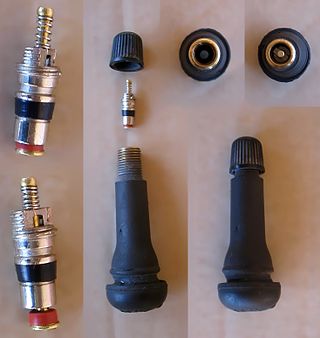
The Schrader valve is a type of pneumatic tire valve used on virtually every motor vehicle in the world today. The Schrader company, for which it was named, was founded in 1844 by August Schrader. The original Schrader valve design was invented in 1891, and patented in the United States in 1893.
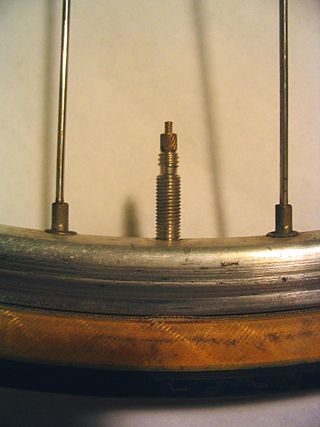
The Presta valve is a tire valve commonly found in high pressure road style and some mountain bicycle inner tubes. It comprises an outer valve stem and an inner valve body. A lock nut to secure the stem at the wheel rim and a valve cap may also be present.

A globe valve, different from ball valve, is a type of valve used for regulating flow in a pipeline, consisting of a movable plug or disc element and a stationary ring seat in a generally spherical body.
The term bicycle tools usually refers to specialty tools only used on bicycles, as opposed to general purpose mechanical tools such as spanners and hex wrenches. Various bicycle tools have evolved over the years into specialized tools for working on a bicycle. Modern bicycle shops will stock a large number of tools for working on different bicycle parts. This work can be performed by a trained bicycle mechanic, or for simple tasks, by the bicycle owner.
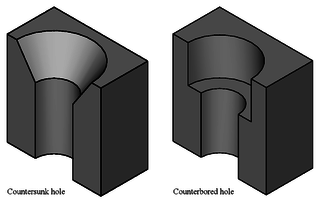
In manufacturing, a countersink is a conical hole cut into a manufactured object, or the cutter used to cut such a hole. A common use is to allow the head of a countersunk bolt, screw or rivet, when placed in the hole, to sit flush with or below the surface of the surrounding material. A countersink may also be used to remove the burr left from a drilling or tapping operation, thereby improving the finish of the product and removing any hazardous sharp edges.
A tire-pressure monitoring system (TPMS) monitors the air pressure inside the pneumatic tires on vehicles. A TPMS reports real-time tire-pressure information to the driver, using either a gauge, a pictogram display, or a simple low-pressure warning light. TPMS can be divided into two different types – direct (dTPMS) and indirect (iTPMS).

A fitting or adapter is used in pipe systems to connect straight sections of pipe or tube, adapt to different sizes or shapes, and for other purposes such as regulating fluid flow. These fittings are used in plumbing to manipulate the conveyance of water, gas, or liquid waste in domestic or commercial environments, within a system of pipes or tubes.
A tubeless tire is a pneumatic tire that does not require a separate inner tube.

Inspection and maintenance of tires is about inspecting for wear and damage on tires so that adjustments or measures can be made to take better care of the tires so that they last longer, or to detect or predict if repairs or replacement of the tires becomes necessary. Tire maintenance for motor vehicles is based on several factors. The chief reason for tire replacement is friction from moving contact with road surfaces, causing the tread on the outer perimeter of tires to eventually wear away. When the tread depth becomes too shallow, like for example below 3.2 mm, the tire is worn out and should be replaced. The same rims can usually be used throughout the lifetime of the car. Other problems encountered in tire maintenance include:
Direct TPMS, or direct tire pressure monitoring systems refers to the use of a pressure sensor directly mounted on the wheels or tires of a vehicle. The pressure inside the tire is measured using a pressure transducer with the pressure information being subsequently sent to the vehicle to warn the driver of under or over inflation of a tire. The pressure information is commonly transmitted to the vehicle using radio frequency (RF) technology, though systems using mechanical, electrical or magnetic methods have been used over recent years.

A screw and a bolt are similar types of fastener typically made of metal and characterized by a helical ridge, called a male thread.















